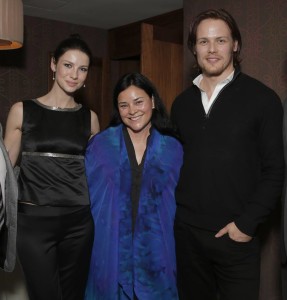 Goodreads asked Diana Gabaldon a lot of questions about Outlander, the TV show, and the upcoming release of Written in My Own Heart’s Blood (aka MOBY). Here are some excerpts, but read the whole interview (it is very detailed and very good) over at Goodreads.
Goodreads asked Diana Gabaldon a lot of questions about Outlander, the TV show, and the upcoming release of Written in My Own Heart’s Blood (aka MOBY). Here are some excerpts, but read the whole interview (it is very detailed and very good) over at Goodreads.
“GR: And after 14 bestsellers in the Outlander universe, this is not yet the last book?
DG: There’s one more. I’ve never been willing to commit to more than one at a time, because I just don’t know—I don’t plan the books out ahead of time. So I have no idea how much ground we’ll cover. But there is certainly one, because I wasn’t finished telling the story at the end of number 8.
GR: Do you already know how it will end, if not how exactly you’ll get there?
DG: Yes and no. I do know what the last scene is, because I wrote that about ten years ago. It popped up in the middle of the night. But it isn’t a plot conclusion; it’s an epilogue. So, in fact, I have no idea where the story is going.
GR: Your readers have often wondered when they’ll learn more about a mysterious scene that appeared in the original book, Outlander. Goodreads member Georgianna Simpson asks, “Will we learn why the ghost of Jamie was looking for Claire in book 1 in this [new] book or do we have to wait for more?”
DG: They do have to wait! It will be the last thing in the last book!
GR: For Written in My Own Heart’s Blood, what intrigues you about the American Revolution for your story’s grand backdrop?
DG: Well, it’s largely an accident of time—that’s what was going on at that stage of their lives! [laughs] But I’m an old enough American to feel absolutely no shame in feeling patriotic. The American Revolution was by and large a very good thing, and the government that resulted from it. One of the things I’m doing here, besides explaining how a very long marriage works, is exploring the geopolitical dynamics of the second half of the 18th century. Now if you come right out and tell people that’s what you’re doing in a book, they won’t read it! So that’s not what’s on top, but it is always there. So we’re looking at the movement of the Enlightenment and how this affected the principles that underlay the American Revolution. We’re looking at some of the personalities who participated and the backgrounds from which they came. And we’re looking at scientific evolution, as well, and the effects of this on what was not quite modern warfare. There’s just a lot of stuff going on in the 18th century, especially the second half. It was one of the greatest periods of social and intellectual ferment the world has ever seen.
GR: Fans are counting down to August 9th for the TV premiere of Outlander on Starz. Do you have any thoughts or advice for people who may become fans of the show, who haven’t yet read the books?
DG: People who come to the books from the show will certainly recognize the first book, because the TV adaptation is quite good. It’s a very faithful adaptation. At the same time, it’s done very well in terms of a visual medium, because you can’t film page by page—it wouldn’t be a good show. You have to do things to a book that make it flow in visual terms. I know a little bit about adapting for a visual medium because I used to write comic books for Walt Disney, so I know how to choose images to carry the flow of the action and dialogue to explain the plot points.”
Source: Goodreads